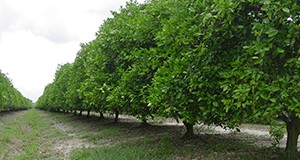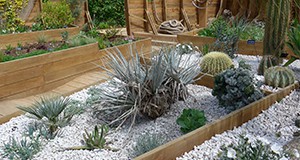When raising crops on calcareous soils, growers need to know how much calcium carbonate is in the soil before they can employ any management practices. Growers can test the level of carbonate in their soils using store-bought vinegar and other household supplies. This 3-page fact sheet explains the chemistry behind the vinegar test and instructions for performing the test and interpreting the results. Written by Qiang Zhu, Monica Ozores-Hampton, and Yuncong Li, and published by the UF Department of Horticultural Sciences, June 2015.
http://edis.ifas.ufl.edu/hs1262
Author: Sam Grenrock
Mechanical Pruning of Citrus Trees

When citrus trees are not regularly pruned, less sunlight reaches the lower parts of the trees, which can reduce flowering and fruit development, quality, and color. Less sunlight also increases the risk of fungal infection. This 3-page fact sheets explains how growers can prune trees to maximize light exposure. Written by Mongi Zekri, and published by the UF Department of Horticultural Sciences, August 2015.
http://edis.ifas.ufl.edu/hs1267
Sand-Clay Mix in Phosphate Mine Reclamation: Characteristics and Land Use

Phosphate rock is a key component in producing fertilizer and many other economically important products. Getting phosphate rock out of the ground produces a by-produce called phosphate clay, which mining operations must return to the landscape. However, phosphate clay retains large amounts of water, making them unsuitable for use as farmland or wildlife habitat. This 6-page fact sheet explains how using a sand-clay mix can more efficiently restore the landscape and put it to beneficial use. Written by Casey Beavers, Edward A. Hanlon, Matt Wilson, James “Bud” Cates, and George J. Hochmuth, and published by the UF Department of Soil and Water Sciences, July 2015.
http://edis.ifas.ufl.edu/ss636
Transparency in Agriculture and Natural Resources: Defining Transparent Communication
When we think about transparency, we usually think about business, public relations, and government; however; transparency is also an important consideration in agriculture and food industries. Defined as openness and the opposite of secrecy, transparency can be conceptualized as a communication strategy that the agricultural industry can use to interact with consumers and other audiences. This 3-page fact sheet defines transparent communication as containing substantial information, incorporating audience participation, and maintaining accountability. Written by Joy N. Rumble, and published by the UF Department of Agricultural Education and Communication, September 2015.
http://edis.ifas.ufl.edu/wc225
Writing and Designing for the Web series
Knowing how to create and design a website is a valuable skill. This four-part series explains general tenants of good web design, covers the terminology and techniques involved in creating appealing, user-friendly websites, and also discusses basic HTML coding and developing visual elements for the web. Written by Ricky Telg, Laura Gorham, and Tracy Irani, and published by the UF Department of Agricultural Education and Communication, August 2015.
http://edis.ifas.ufl.edu/topic_series_writing_and_designing_for_the_web
Priority Competencies Needed by UF/IFAS Extension County Faculty

Research shows that competency is a better indicator of employee potential than intelligence alone. This 5-page fact sheet outlines ten competency areas relevant to Extension county faculty, as well as examples of how Extension faculty might embody these qualities in their work. Written by Amy Harder, and published by the UF Department of Agricultural Education and Communication, September 2015.
http://edis.ifas.ufl.edu/wc236
Teaching to Personality Types series

A person’s personality affects the way he or she learns best. Extension programs can use an understanding of different learning styles and preferences to reach the greatest number of people. This 4-part series covers the various personality types and explains how Extension can teach to these types. Written by Alexa J. Lamm and Ricky W. Telg, and published by the UF Department of Agricultural Education and Communication, September 2015. (Photo credit: Rawpixel Ltd/iStock/Thinkstock.com)
http://edis.ifas.ufl.edu/topic_series_teaching_to_personality_types
Preventing Foodborne Illness: Bacillus cereus

Ingesting foods contaminated with Bacillus cereus bacteria can lead to nausea, vomiting, abdominal cramps, and diarrhea. Though B. cereus is commonly found in many types of fresh and processed foods, proper cooking, handling, and storage can minimize the risk of contamination. This 5-page fact sheet explains how B. cereus is transmitted, what foods it is commonly associated with, the methods used to prevent contamination, and good practices for receiving, handling, processing, and storing food. Written by Keith R. Schneider, Renée Goodrich Schneider, and Rachael Silverberg, and published by the UF Department of Food Science and Human Nutrition, August 2015.
http://edis.ifas.ufl.edu/fs269
Implications of Cow Body Condition Score on Productivity
Body condition score (BCS) indicates how much fat a cow has on its body, which is an important factor in cow health and reproductive capacity. Growers can use BCS to understand and manage the health of a herd and maintain a profitable operation. This 6-page fact sheet explains how BCS is measured, what different scores mean, the economic impact of various scores, and how changing cow nutrition can move BCS in a desired direction. Written by Matt Hersom, Todd Thrift, and Joel Yelich, and published by the UF Department of Animal Sciences, September 2015.
http://edis.ifas.ufl.edu/an319
Resetting in Citrus Groves

To maintain the overall productivity of a citrus grove, dead or declining trees should be promptly removed and replaced with young, healthy trees, a practice known as resetting. Resetting presents many challenges for growers because young trees require more attention and care than more established trees. This 4-page fact sheet discusses effective resetting methods and maintenance for citrus. Written by Zekri Mongi, and published by the UF Department of Horticultural Sciences, August 2015.
http://edis.ifas.ufl.edu/hs1266
Implants for Cow-Calf and Stocker Beef Cattle

Getting cattle to put on a lot of muscle quickly is a crucial part of a beef cattle operation’s profitability. Growth promoting implants are one of the most cost-effective ways of increasing lean tissue in cattle and work by releasing hormones into the cow’s body that encourage muscle growth. This 4-page fact sheet explains implants’ mechanisms of action, how implants are administered and used, and concerns associated with implants. Written by Matt Hersom and Todd Thrift, and published by the UF Department of Animal Sciences, August 2015.
http://edis.ifas.ufl.edu/an318
“Candidatus Liberibacter solanacearum”: An Emerging Pathogen Infecting Potato and Tomato

A bacterium called “Candidatus Liberibacter solanacearum” infects potatoes and tomatoes, causing zebra chip in potatoes and psyllid yellows in tomatoes. These disease are highly destructive and have been known to reduce yields by up to 85%. “Ca. L. solanacearum” has been reported in several states, though it has not been detected in Florida, which is the second largest producer of tomatoes and seventh largest producer of potatoes in the US. This 9-page fact sheet covers the biology, distribution, symptoms, transmission, diagnosis, and management of the pathogen and its associated diseases. Written by Binoy Babu, Mathews L. Paret, Nicholas Dufault, and Carrie L. Harmon, and published by the UF Department of Plant Pathology, August 2015.
http://edis.ifas.ufl.edu/pp320
Strategies to Encourage Adoption of Stormwater Pond Best Management Practices (BMPs) by Homeowners
Man-made ponds can be a useful way to collect, store, and treat stormwater runoff in residential areas. However, these ponds can become polluted when runoff contains fertilizers, pesticides, and pet waste from the neighborhood. This 8-page fact sheet outlines several best management practices (BMPs) for reducing stormwater pond pollution. Based on a survey of residents who live near stormwater ponds, the authors recommend strategies Extension educators can use to encourage residents to adopt these BMPs. Written by Emily Ott, Paul Monaghan, Ondine Wells, Gail Hansen, Laura Warner, and Michelle Atkinson, and published by the UF Department of Agricultural Education and Communication, July 2015.
http://edis.ifas.ufl.edu/wc214
Value-Added Products for Fresh Highbush Blueberries

Blueberries are one of the most popular fruits worldwide. Blueberries’ health benefits have fueled this popularity, and today, blueberries can be found in products ranging from nutritional supplements to pet food. This 4-page fact sheet covers the processing methods such as freezing or drying that transform fresh blueberries into ingredients that can be used in other products. Written by Ruiqi Li and Liwei Gu, and published by the UF Food Science and Human Nutrition Department, June 2015.
http://edis.ifas.ufl.edu/fs268
Getting the Most out of Social Media

Agriculturalists can use social media as a powerful tool for marketing their products and establishing a brand identity. The goal of this series is to help agriculturalists understand how social media can work for them. The series also discusses the various social media platforms and how to use social media strategically and wisely. Written by Jessica C. Fernandez and Joy N. Rumble, and published by the UF Department of Agricultural Education and Communication, August 2015. (Photo credit: tanuha2001/iStock/Thinkstock.com)
http://edis.ifas.ufl.edu/topic_series_getting_the_most_out_of_social_media
Letting Them In: Sharing Your Story with People outside of Your Industry

Those who work in agriculture often face the challenge of explaining their work to people outside of their field. Identifying what your audience cares about is the first step in formulating a story you audience will understand and value. This 3-page fact sheet also offers do’s and don’ts for crafting a story for non-expert audiences. Written by Brandon Telg, Jaron Jones, and Ricky Telg, and published by the UF Department of Agricultural Education and Communication, July 2015. (Photo credit: monkeybusinessimages/iStock/Thinkstock.com)
http://edis.ifas.ufl.edu/wc216
Story Development
Stories let you share who you are with the world. Storytelling can help develop an organization’s identity, improve interactions with the public, and foster teamwork. This 2-page fact sheet covers the basics of good storytelling and strategies for crafting an engaging story. Written by Brandon Telg, Jaron Jones, and Ricky Telg, and published by the UF Department of Agricultural Education and Communication, July 2015. (Photo credit: elwynn1130/iStock/Thinkstock.com)
http://edis.ifas.ufl.edu/wc215
Turfgrass Herbicides: Mechanisms of Action and Resistance Management
Herbicides are an effective tool for controling weeds in turfgrass; however, weeds can become resistant to herbicides and create significant problems for turfgrass production. The best way to combat herbicide resistance is to rotate herbicides with different mechanisms of action (MOA) because using herbicides with different MOAs makes it more likely that weeds resistant to one herbicide will encounter an herbicide to which they are not resistant. This 4-page fact sheet focuses on how to create an herbicide program that uses different MOAs to manage resistant weeds. Written by Ramon G. Leon and Bryan Unruh, and published by the UF Department of Agronomy, August 2015.
http://edis.ifas.ufl.edu/ag398
A Manual for the Design and Implementation of Teaching and Demonstration Gardens

Teaching and demonstration gardens are places where the public can learn about different types of gardens and landscapes. This 10-page fact sheet discusses the various types of gardens, how to plan and develop a demonstration garden, logistical and design considerations, and educational programming. Written by Gail Hansen, and published by the UF Environmental Horticulture Department, July 2015.
http://edis.ifas.ufl.edu/ep524
Storytelling through Social Media
You and organization can use social media to tell you story and reach a large and diverse audience. This 3-page factsheet covers the major social media platforms, what each platform offers, and how to use theme effectively. Written by Brandon Telg, Jaron Jones, Ricky Telg, and Becky Raulerson, and published by the UF Department of Agricultural Education and Communication Department, July 2015.
http://edis.ifas.ufl.edu/wc218







